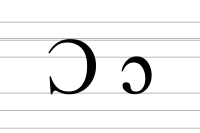| Ɔ | |
|---|---|
| Ɔ ɔ | |
 | |
| Usage | |
| Writing system | Latin script |
| Type | Alphabetic and Logographic |
| Unicode codepoint | U+0186, U+0254 |
| History | |
| Development |
|
| Other | |
| Writing direction | Left-to-Right |
Open o or turned c (majuscule: Ɔ, minuscule: ɔ) is a letter of the extended Latin alphabet. In the International Phonetic Alphabet, it represents the open-mid back rounded vowel. It is used in the orthographies of many African languages using the African reference alphabet.
The Yucatec Maya language used Ɔ as a consonant in the orthography of the Colonial period. Now dz or tz' is preferred.
Unicode
| Preview | Ɔ | ɔ | ||
|---|---|---|---|---|
| Unicode name | LATIN CAPITAL LETTER OPEN O | LATIN SMALL LETTER OPEN O | ||
| Encodings | decimal | hex | dec | hex |
| Unicode | 390 | U+0186 | 596 | U+0254 |
| UTF-8 | 198 134 | C6 86 | 201 148 | C9 94 |
| Numeric character reference | Ɔ | Ɔ | ɔ | ɔ |
On the macOS US Extended keyboard, ɔ and Ɔ can be typed with ⌥ Option+: followed by c or C.
On a personal computer, ɔ can be typed by holding the ALT key and typing 596 on the number keypad. The capital Ɔ can be typed similarly by using ALT+390.
Related characters
Descendants and related characters in the Latin alphabet
- Ɔ with diacritics: ɔ́ ɔ̀ ɔ̃ ᶗ[1]
- Uralic Phonetic Alphabet-specific symbols related to Ɔ :[2]
- U+1D10 ᴐ LATIN LETTER SMALL CAPITAL OPEN O
- U+1D12 ᴒ LATIN SMALL LETTER SIDEWAYS OPEN O
- U+1D53 ᵓ MODIFIER LETTER SMALL OPEN O
Similar looking letters

Open o looks like a reversed letter 'C'. Claudius introduced a Ɔ (the antisigma) with the intention of replacing bs and ps.
_Norsk_ordbog_med_dansk_forklaring._Christiania_-_p.175.png.webp)
The Scandinavian explanatory symbol (forklaringstegnet) can be typeset using the open o followed by a colon, thus: ɔ:. It is used to mean "namely", "id est", "scilicet" or similar.[3]
This letter is often used to refer to the Copyleft official sign, which looks like an open o with a circle around it.
See also
References
- ↑ Constable, Peter (2004-04-19). "L2/04-132 Proposal to add additional phonetic characters to the UCS" (PDF).
- ↑ Everson, Michael; et al. (2002-03-20). "L2/02-141: Uralic Phonetic Alphabet characters for the UCS" (PDF).
- ↑ "Forklaringstegnet: en savnet del av det typografiske repertoar?". Typografi i Norge (in Norwegian). 2006-08-02 [last updated 2010-09-29]. Archived from the original on 2020-11-05.